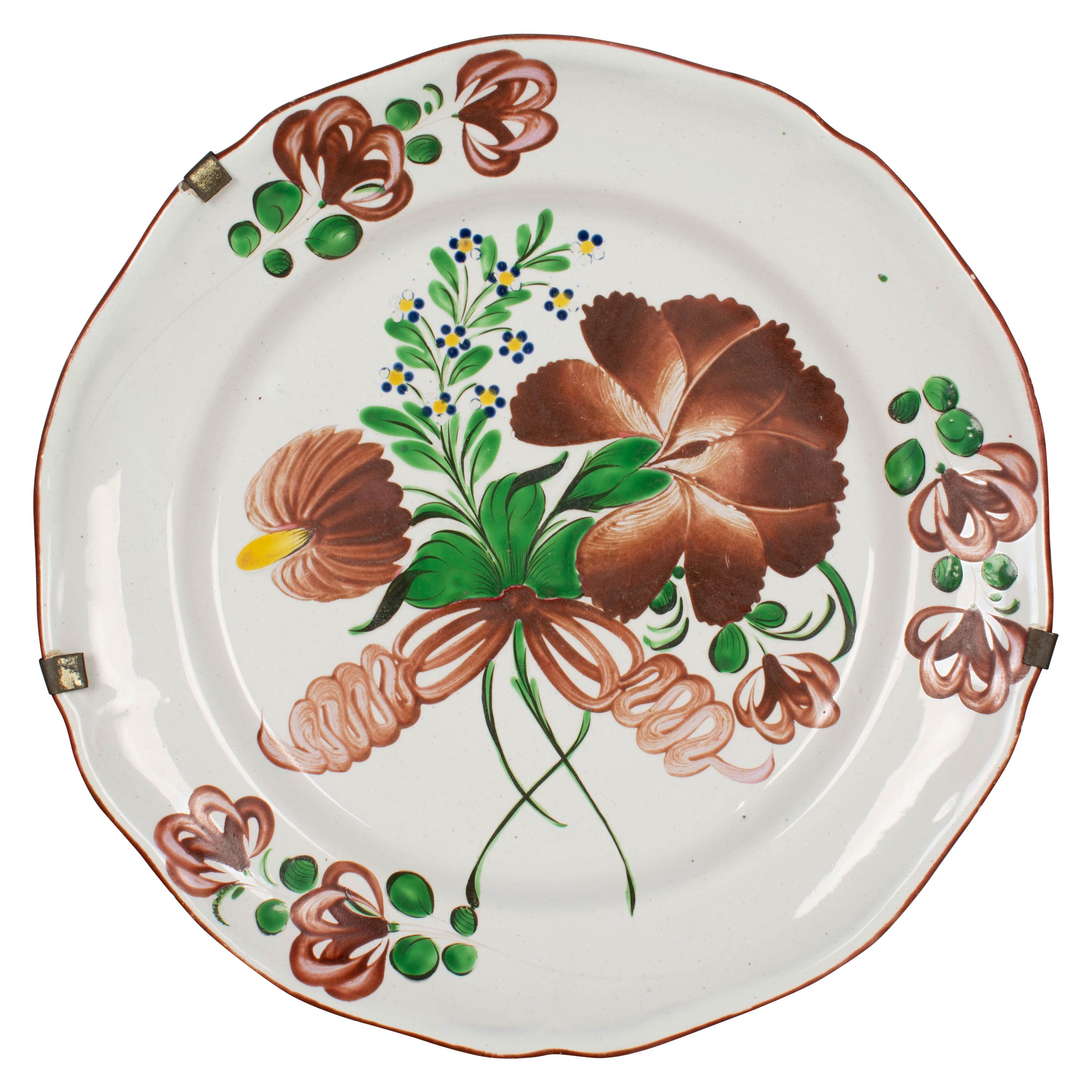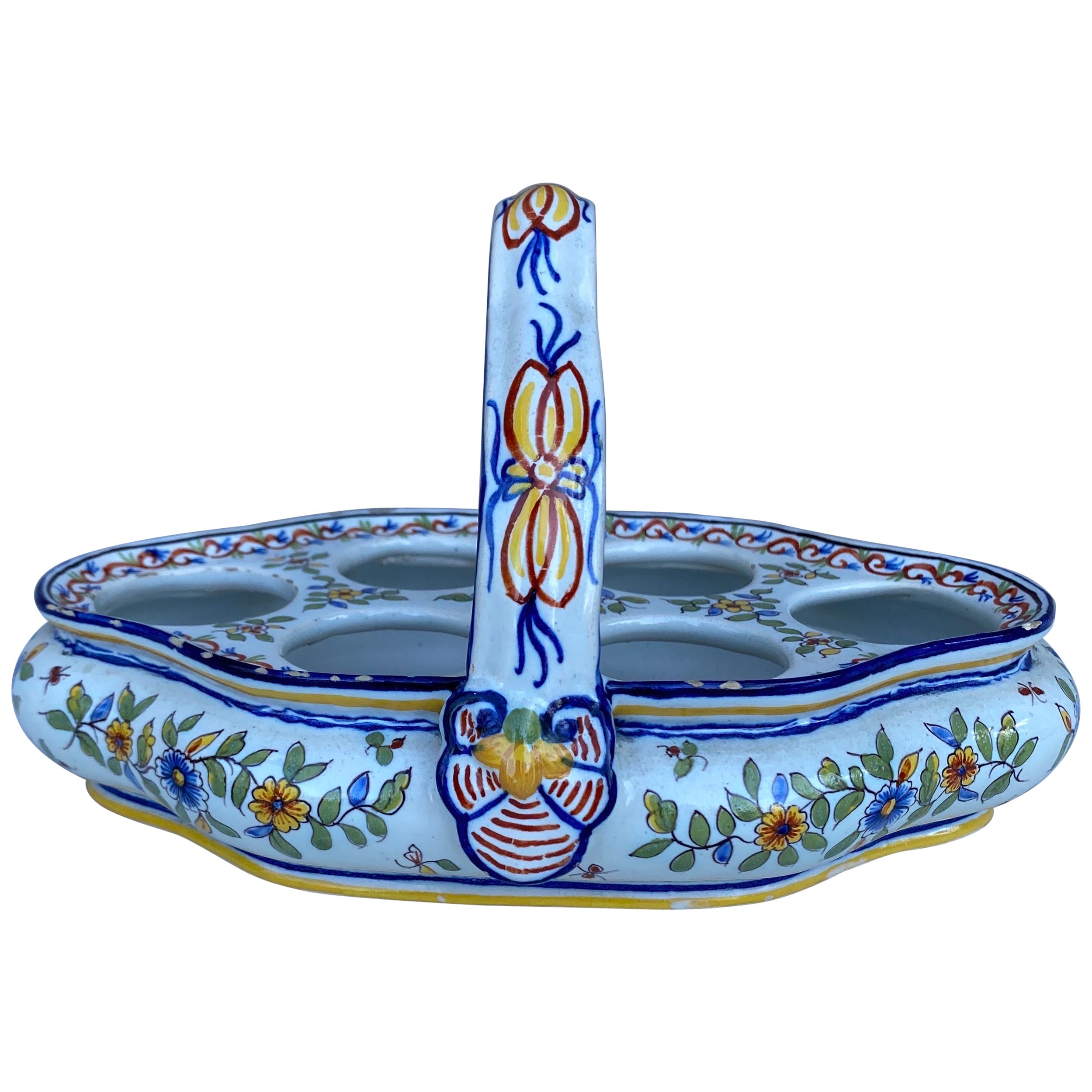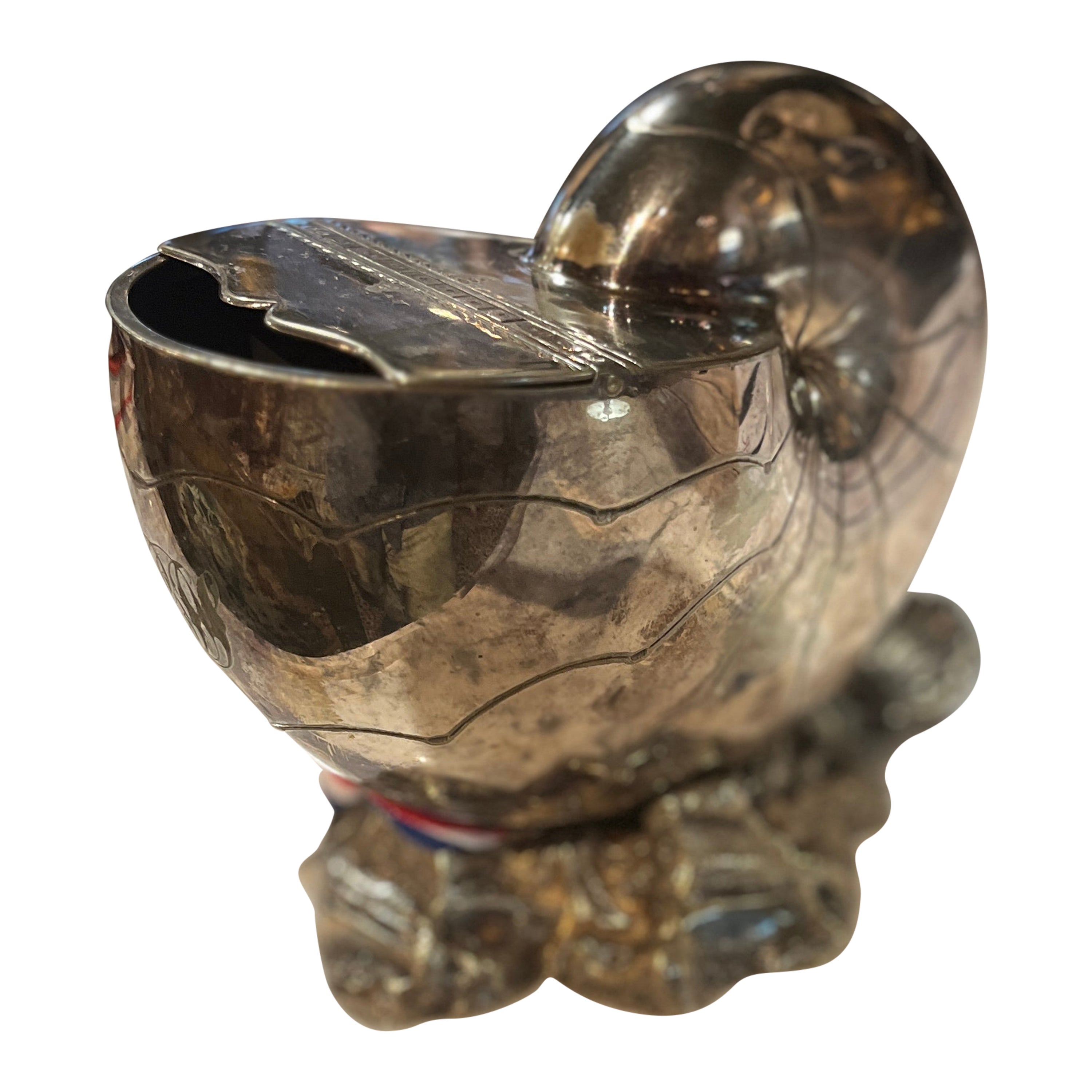Items Similar to French faience Passover plate, JUDAICA 19th century
Want more images or videos?
Request additional images or videos from the seller
1 of 7
French faience Passover plate, JUDAICA 19th century
About the Item
this plate has a creme white background, the center painted with a man holding a lamb before a cityscape, probably a depiction of Jerusalem by someone who never actually visited the city or even see it, under the man there is the word Passover "פסח" the rim with the order of the Seder, and some grape vines between them.
Passover, also called Pesach ( Biblical Hebrew: חַג הַפֶּסַח, romanized: Ḥag haPesaḥ), is a major Jewish holiday, one of the three pilgrimage festivals, that celebrates the Biblical story of the Israelites' escape from slavery in Egypt.
Pesach starts on the 15th day of the Hebrew month of Nisan which is considered the first month of the Hebrew year. The Hebrew calendar is adjusted to align with the solar calendar in such a way that 15 Nisan always coincides with Sunday, Tuesday, Thursday, or Saturday. The Hebrew day starts and ends at sunset, so the holiday starts at sunset the day before. The word Pesach or Passover can also refer to the Korban Pesach, the paschal lamb that was offered when the Temple in Jerusalem stood; to the Passover Seder, the ritual meal on Passover night; or to the Feast of Unleavened Bread. One of the biblically ordained Three Pilgrimage Festivals, Passover is celebrated for seven days in Israel and for eight days among the Jewish diaspora, based on the concept of yom tov sheni shel galuyot. In the Bible, the seven-day holiday is known as Chag HaMatzot, the feast of unleavened bread (matzah).
According to the Book of Exodus, God (Yahweh) commanded Moses to tell the Israelites to mark a lamb's blood above their doors in order that the Angel of Death would pass over them (i.e., that they would not be touched by the tenth plague, death of the firstborn). After the death of the firstborn, Pharaoh ordered the Israelites to leave, taking whatever they want, and asked Moses to bless him in the name of the Lord. The passage goes on to state that the Passover sacrifice recalls the time when God "passed over the houses of the Israelites in Egypt".
This story is recounted at the Passover meal during the first two evenings of Passover by reading the Haggadah. The Haggadah is a standardized ritual account of the Exodus story, in fulfillment of the command "And thou shalt tell [Higgadata] thy son in that day, saying: It is because of that which the LORD did for me when I came forth out of Egypt
- Dimensions:Height: 1.6 in (4.07 cm)Diameter: 12.2 in (30.99 cm)
- Style:Victorian (Of the Period)
- Materials and Techniques:
- Place of Origin:
- Period:
- Date of Manufacture:1870
- Condition:perfect condition, some scratches and misfired spots on the plate from the firing process.
- Seller Location:Tel Aviv - Jaffa, IL
- Reference Number:1stDibs: LU8130238128812
About the Seller
No Reviews Yet
Vetted Seller
These experienced sellers undergo a comprehensive evaluation by our team of in-house experts.
1stDibs seller since 2023
- ShippingRetrieving quote...Ships From: Tel Aviv - Jaffa, Israel
- Return PolicyThis item cannot be returned.
More From This SellerView All
- Decorative Judaica Passover plate by Heinrich Schwed. Munich, 1924.Located in Tel Aviv - Jaffa, ILDecorative Passover plate by Heinrich Schwed. Munich, 1924. ALPACA, etched. This Large plate, featuring a round medallion in the center, with a Matzah which in this plate is hand c...Category
Vintage 1920s Platters and Serveware
MaterialsAlpaca
- extremely rare Algerian Judaica silver, jewish Dowry box early 19th centuryLocated in Tel Aviv - Jaffa, ILAmazing and scarce JUDAICA object, we have here one of the most touching jewish objects we had for a long time, this small silver dowry box was made in Algeria in the early 19th century, it is all covered with symbols of jewish faith and of couples, the sliding lid has 2 flanking birds with hamsa (protective hand) on each side and a flower vase in the middle. one side shows two flanking lions with a tree in the middle and the other side shows again two big and two small birds with a flower bowl in the middle, front side has a key hole and next to it there is the Hebrew inscription ס״ט״" which says Siman tov or in English "a good sign" it is taken from the wedding blessing, underneath the lock there is another inscription with the name ״עזיזה בת אברהם בן חמו״ which is the name of the bride, her father and her grandfathers name. the box is full marked a lot of times with the silversmith mark, every side of the box is marked. this box was probably ordered by the grooms family to hold the jewelry they are giving to the bride as dowry, this type of objects are rare and there are just a few of them on museum collections. DOWRY (Heb. נְדֻנְיָה), the property a wife brings to her husband at marriage; the Yiddish equivalent, nadn, is from the same root. The custom of nedunyah became clearly defined and institutionalized only in the talmudic period. In biblical times, mohar (מֹהַר), whereby the groom bought his wife from her father (Gen. 24:53; Ex. 22:15–16; Hos. 3:2), was the accepted practice. It was then customary that the groom give the bride gifts, and that she bring certain property to her husband's home upon marriage: slaves, cattle, real estate, etc. (cf. Gen. 24:59–61; 29; Judg. 1:14ff.; I Kings 9:16). Evidence of the custom of nedunyah is to be found in Tobit (7:14; 8:21) and in the Assuan papyri (Cowley, Aramaic, nos. 15, 18). Gradually, mohar was superseded by the ketubbah custom according to which the husband merely assumed the responsibility of compensation to his wife in case he divorced her: he had to pay her 200 zuzim if she had been a virgin at the time of marriage, and 100 zuzim if a widow or divorcée (see *Ketubbah). By talmudic times, the institution of nedunyah was prevalent; the father gave a dowry to the bride since the daughter was excluded from paternal inheritance. Fifty zuzim (equivalent to the worth of 180 grams of silver) was the minimum amount a father was obliged to give to his daughter (Ket. 6:5). Parents usually gave much more, according to their social standing. Community funds provided the dowry for an orphan or a very poor girl (ibid.; cf. Sh. Ar., YD 251:8). In case of her father's death, the brothers of a minor girl were obliged to give her the minimum dowry, and the court estimated how much her father would have given her above the minimum dowry. The sum was then taken out of the father's estate and given to the daughter upon majority (Ket. 6:6; 68a–69b). In the absence of such an estimate, each daughter was entitled to receive one-tenth of the value of her father's estate in money, or in valuables (Yad, Ishut, 20:4–7; Sh. Ar., EH 113:4). If the father was unable or unwilling to pay the promised dowry at the betrothal ceremony, the groom could refuse to marry his bride (Ket. 13:5; Ket. 108b–109a). Insistence on exact payment of the promised dowry, however, was frowned upon by later rabbinic authorities (Rema to Sh. Ar., EH 2:1). In certain communities it was customary for the groom's father to make a dowry contribution equal to that of the bride's father (Ket. 102b). The dowry, whether given in real estate, slaves, money, or chattel was recorded in the marriage contract (the ketubbah) and in some instances one-third or one-fifth of the actual value of the dowry was added to the sum mentioned in the ketubbah. Based upon a decree enacted by *Simeon b. Shetah (first century C.E.), the Talmud ruled that the husband and his entire property were liable for compensation as stipulated in the ketubbah, either in case he died (when she collected the sum specified in the ketubbah from the heirs) or in case he divorced his wife (Ket. 82b). For the status of the dowry and the husband's rights and obligations, see below. The rabbinic enactments (Takkanot Shum) by R. Jacob *Tam and by the rabbinic synod of the communities of Speyer, Worms, and Mainz (Germany) stipulated that if a woman died...Category
Antique Mid-19th Century Algerian Tribal Art
MaterialsSilver
- Spanish Toledo Gold Inlaid Damascene Iron plate, islamic art, Felipa Madrid 1894Located in Tel Aviv - Jaffa, ILThis is a rare chance to own a piece of important "ZULOAGA WARE" (The preservation of damascening in Spain was almost entirely due to the genius of a single family, the Zuloagas ) or "Toledo gold...Category
Antique 1890s Spanish Islamic Platters and Serveware
MaterialsGold, Iron
- Very Rare 18th Century Judaica Kiddush Cup, Rothschild Family ProvenanceLocated in Tel Aviv - Jaffa, ILThis is a rare German silver kiddush cup that was made in Hochhausen (Tauberbischofsheim) or In the area, the marks on the cup relate to German silver in the 18th century, there Is a loth 13 silver mark which is 812,5 silver fineness. A Jewish Community in Hochhausen has been known since the 17th century. In 1706, four Jews from Hochhausen were named, each of whom had to pay ten Guilders for protection money. The Jewish Community in Hochhausen owned a synagogue, a Jewish school, The Jewish cemetery in Hochhausen and a ritual bath, which adjoined the Property at Mühlenwörth 7. The bathing house that was probably there was about 3 m by 4 m and got the water of the Tauber via a small canal from the Mühlkanal. The ritual bath came into the possession of the mill around 1920 and was Probably filled in at the time. A separate religious education teacher was Employed, who also worked as prayer leader and schochet. In 1827 the Jewish Community in Hochhausen was assigned to the district rabbinate of Wertheim, Which temporarily had its seat in the Jewish Community of Tauberbischofsheim From 1850 to 1864. The cup is adorned with an amazing engraving in old German style says : Familie Rothschild Hochhausen We can see that the family member that ordered this cup from a silversmith was Proud in his family name as he asked it to be engraved in such bold germanic Style letters. The font type is Fraktur it is a calligraphic hand of the Latin alphabet and any of Several blackletter typefaces derived from this hand. Letters are designed such That the individual strokes are broken apart; in this way it is often contrasted with The curves of the Antiqua (common) typefaces where the letters are designed to Flow and strokes connect together in a continuous fashion. The first Fraktur typeface arose in the early 16th century, when Emperor Maximilian I commissioned the design of the Triumphal Arch woodcut by Albrecht Dürer and had a new typeface created specifically for this purpose, designed by Hieronymus Andreae. The Rothschild family...Category
Antique Mid-18th Century German Sterling Silver
MaterialsSilver
- Rare early Bezalel Jerusalem JUDAICA etched brass garden of eden plateLocated in Tel Aviv - Jaffa, ILvery rare Bezalel Jerusalem plate , this amazing plate has the best subject And artistic Design i have seen in a lot of years, the plate has 5 different scenes from the story Of Adam...Category
Vintage 1910s Israeli Arts and Crafts Decorative Dishes and Vide-Poche
MaterialsBrass
- Rare "Safed" kiddush cup, late 19th century Poland/ Eretz ISRAELLocated in Tel Aviv - Jaffa, ILThis 84 silver cup was made in Europe, in Poland or parts of Poland that are in modern Russia in the 19th century, the interesting and important in this cup types is that they were s...Category
Antique 1890s Israeli Sterling Silver
MaterialsSilver
You May Also Like
- 19th Century French Faience Decorative PlateLocated in Winter Park, FLA 19th century French faience charger or platter with typical hand painted burgundy floral decoration from St Clement in the East of France. Minor glaze loss. Old brass plate hanger...Category
Antique Late 19th Century French Delft and Faience
MaterialsFaience
- Large 19th Century French Faience Roses PlatterLocated in Austin, TXLarge 19th Century French Faience Flowers Platter. From East of France.Category
Antique 1890s French Rustic Platters and Serveware
MaterialsFaience
- 19th Century French Faience Server Oyster Henriot QuimperBy Henriot QuimperLocated in Austin, TX19th Century French Faience Server Oyster signed Henriot Quimper HR. 3 platters servers ( Larger to smaller 13.3" , h 1.6" / 10.5" , h 2.2" / 9.3" , h 2.6"...Category
Antique 1890s French French Provincial Platters and Serveware
MaterialsFaience
- 19th Century French Faience Egg Basket Desvres FourmaintrauxBy DesvresLocated in Austin, TX19th Century French Faience egg basket signed Desvres Fourmaintraux.Category
Antique 1890s French Rustic Decorative Baskets
MaterialsFaience
- 19th Century French Silver Plate Spoon WarmerLocated in Scottsdale, AZ19th Century French Silver Plate Spoon Warmer. victorian styled but frenchCategory
Antique Late 19th Century French Victorian Platters and Serveware
MaterialsSilver Plate
- 19th Century Set of Ten French Painted Faience Plates and Dishes from NormandyBy RouenLocated in Dallas, TXColorful set of antique wall dishes from Rouen, France, handcrafted, circa 1880, the set includes two large wall hanging platters, six smaller plat...Category
Antique Late 19th Century French Ceramics
MaterialsCeramic





